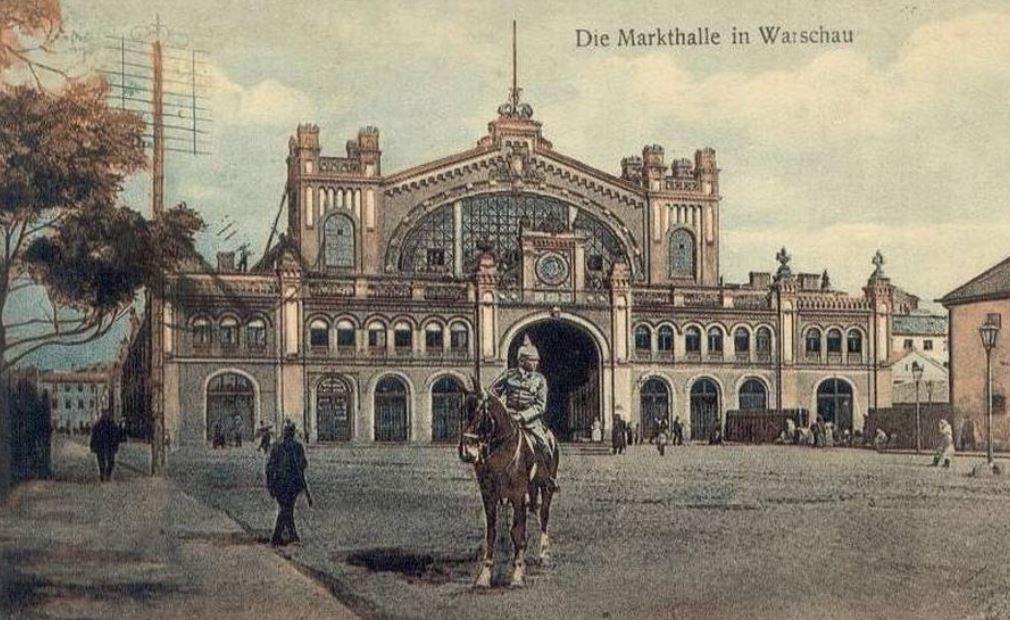Hale Mirowskie to bliźniacze neoromańskie hale targowe wybudowane w latach 1899-1901. Powstały w miejscu rozebranych, osiemnastowiecznych Koszar Mirowskich (stąd tez nazwa osiedla a wywodząca się od Wilhema Miera – Szkota, generała-majora wojsk koronnych, dowódcy pułku wojsk stacjonujących na terenie właśnie Warszawskiego Mirowa).
Od chwili powstania Hale Mirowskie stały się największym obiektem handlowym w Warszawie. Sprzedać i kupić można tu było dosłownie wszystko, choć najwięcej klientów przyciągało świeże mięso, ryby, warzywa, owoce oraz pieczywo. Zgiełk i tłok, który tu panował, sprzyjał też niestety drobnym złodziejaszkom, przed których nowym trickiem, już w 1932 roku przestrzegał „Głos Stolicy” – „W okolicy Hal Mirowskich grasuje banda łobuzów, którzy wynaleźli nowy sposób okradania kupujących. Najprzód jeden z nich pluje komuś na ubranie i odchodzi. Drugi wtedy podchodzi do oplutego i niby z dobrego serca, pokazuje co mu uczyniono, pomagając przytem wycierać. Opluty obywatel stawia paczki na ziemi, by się wytrzeć, wtedy trzeci opryszek kradnie paczki.”. Dobre nie? 😉
Było to tak popularne i uczęszczane miejsce, że zaznaczono je z wyszczególnieniem stacji „Plac Żelaznej Bramy”, na projekcie budowy metra warszawskiego z 1938 roku. Do budowy metra oczywiście nie doszło, ale Halom Mirowskim w stanie nienaruszonym udało się przetrwać nie tylko we wrześniu 1939 roku oblężenie Warszawy, ale i pierwsze lata wojny, aż do wybuchu Powstania Warszawskiego.
Hale Mirowskie w pierwszych dniach sierpnia były miejscem tragicznych wydarzeń – masowych egzekucji ludności cywilnej z terenu zachodniego Śródmieścia i Woli. Na cegłach, nawet po niedawnym remoncie nadal widać ślady po kulach. 7-go i 8-go sierpnia 1944 roku hitlerowcy rozstrzelali tu 510 osób – to miejsce uświęcone krwią Polaków poległych za wolność ojczyzny…
W nocy z 30 na 31 sierpnia 1944 nastąpiło natarcie Niemców. Hale zostały spalone, ale ich mury nadal stały.
Po wojnie nad całkowicie spalonymi Halamizawisło widmo rozbiórki, gdyż ich wygląd nie pasował do koncepcji urbanistycznej Osi Saskiej i w ogóle do komunistycznej wizji miasta. Uratował je… francuski autobus Chausson.
Otóż, jednym z warunków zakupu postawionym przez Francuzów było serwisowanie tych autobusów w zamkniętych pomieszczeniach, w zniszczonej Warszawie hale nadawały się do tego idealnie, była to także ich zajezdnia. Dzięki temu możemy je podziwiać do dziś 
Pierwsze trzy zdjęcia to Hale z początku XX wieku, I Wojny Światowej oraz 1932 roku. Kolejne to okupacja niemiecka i Powstanie Warszawskie, następnie Hale dziś i odnowiony autobus Chausson, który był podstawą komunikacji miejskiej w pierwszych latach po wojnie
Hale Mirowskie a twin Neo-Romanesque halls built in 1899-1901. Built on the site of demolished, eighteenth-century Barracks Mirowskie (hence also the name of a borough stemming from Wilhelm Mier- Scot, Major-General of the Polish royal army, regimental commander of troops stationed in Warsaw Mirów area).
Since the beginning Hale Mirowskie had become the largest retail facility in Warsaw. One could literally buy or sell almost everything, although most customers were attracted by fresh meat, fish, vegetables, fruit and bread. The tumult and the crowd that here prevailed, favored also, unfortunately, fine thieves, against whose new trick, already in 1932 warned „Voice of Capital” – „The neighborhood Hal Mirowskie prowl gang of bullies who invented a new way to defraud buyers. First a one of them spits someone’s clothes and goes, the second then approaches the spitted one and out of good heart shows what other just have done, besides helps wipe the victim. Spitted citizen puts the package on the ground to wipe off, then the third thug steals the package.” Good one huh? 😉
The place was so popular and frequented that was marked as a station „Square Iron Gate” on the project plans of subway in Warsaw in 1938. For the construction of the subway, of course, it did not happen, but Hale Mirowskie intact managed to survive not only in September 1939 siege of Warsaw, but the first years of the war, until the outbreak of the Warsaw Uprising.
Hale Mirowskie in the first days of August were a witnesses of tragic events – mass executions of civilians from the area of the western downtown and Wola. On the bricks, even after the recent renovation still you can see bullet holes. On 7th and 8th August 1944, the Nazis executed here 510 people – this place sanctified by the blood of Poles who died for the freedom of our homeland …
On the night of 30 on August 31, 1944 after the Germans attack Halls all but walls were burned. After the war, the completely burned Halls were destined to demolition because their appearance did not fit into the concept of urban Saxon Axis and in general to the communist vision of the city. It was saved by … French bus Chausson.
Well, one of the conditions of purchase that was put by the French was the service of these buses in closed facilities, in the destroyed Warsaw Halls were suitable for this ideally, it was also the buses’ depot. As a result, we can admire them today 
In the first three photos there are Halls of the early twentieth century , World War I and 1932 . Another is the German occupation and the Warsaw Uprising , then Halls today and renovated bus Chausson , which was the basis of public transport in the first years after the war

